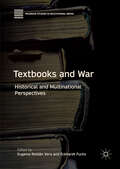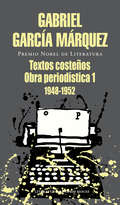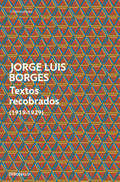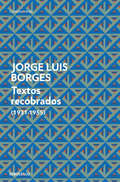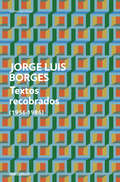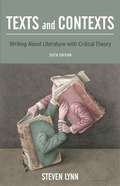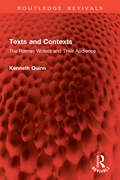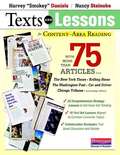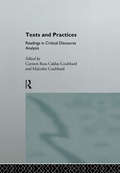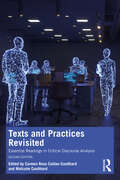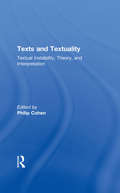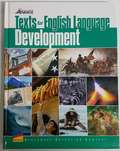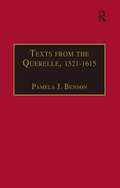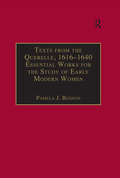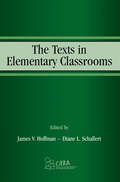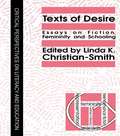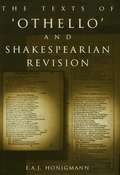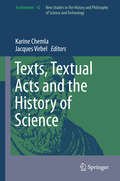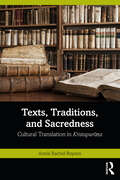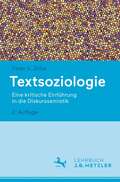- Table View
- List View
Textbooks and War: Historical and Multinational Perspectives (Palgrave Studies in Educational Media)
by Eugenia Roldán Vera Eckhardt FuchsThis volume reflects on the role played by textbooks in the complex relationship between war and education from a historical and multinational perspective, asking how textbook content and production can play a part in these processes. It has long been established that history textbooks play a key role in shaping the next generation’s understanding of both past events and the concept of ‘friend’ and ‘foe’. Considering both current and historical textbooks, often through a bi-national comparative approach, the editors and contributors investigate various important aspects of the relationships between textbooks and war, including the role wars play in the creation of national identities (whether the country is on the winning or losing side), the effacement of international wars to highlight a country’s exceptionalism, or the obscuring of intra-national conflict through the ways in which a civil war is portrayed. This pioneering book will be of interest and value to students and scholars of textbooks, educational media and the relationships between curricula and war.
Textos costeños: Obra periodística, 1 (1948-1952)
by Gabriel García MárquezEn este primer volumen de la Obra periodística de García Márquez, que abarca el período desde que empezó a escribir para El Universal de Cartagena, en mayo de 1948, hasta diciembre de 1952, ya se advierte el pensamiento y la pasión del autor. Los artículos que componen Textos costeños, primer volumen de la Obra periodística de Gabriel García Márquez, abarcan el período que va de mayo de 1948 a diciembre de 1952. Por un lado constituyen los primeros escritos de un joven de veinte años que llegaría a ser el novelista hispánico más importante de la actualidad y, por otro, son el testimonio del convulsionado mundo colombiano tras la muerte de Jorge Eliécer Gaitán, el 9 de abril de 1948. Los comienzos de Gabriel García Márquez como redactor de El Universal supondrían el punto de partida de una conmoción literaria que ha influido profundamente en la literatura contemporánea. El hecho más puntual, la noticia más cotidiana, se inscriben en el universo de magia literaria privativo del gran creador de Cien años de soledad,El otoño del patriarca y Crónica de una muerte anunciada. En muchos casos, estos impecables textos -recopilados y prologados por Jaques Gilard- se convierten en la explicación de ámbitos que en sus novelas están en forma alusiva. En ellos se encontrarán ecos de la temática de su obra literaria, modificados mil veces por el golpe de luces nuevas. Cronológicamente contemporáneos -como contrapunto y ritmo- de sus novelas y cuentos, advierten que el pensamiento y la pasión -en unos momentos- son los mismos, y el tema en literatura es tan único -y tan diverso- como la vida.
Textos recobrados (1919-1929)
by Jorge Luis BorgesPrimero de los tres libros que recogen la obra miscelánea e inédita del maestro Borges. «Alguna noche, suelo ubicar mis horas en la serenidad del barrio de Almagro: empresa que tiene su poco de catástrofe en cada punta, pues para ir y volver es obligatorio descender a la tierra como los muertos e incluirse en una hilera de ajetreos que hay entre la plaza de Mayo y la estación Loria, y resurgir con una sensación de milagro incómodo y de personalidad barajada, al mundo en que hay cielo. Claro está que esas plutónicas y agachadas andanzas tienen su compensación: tal vez la más segura es poder considerar ese grande y bien iluminado plano de Buenos Aires que ilustra las paredes enterradas de los andenes. ¡Qué maravilla definida y prolija es un plano de Buenos Aires! Los barrios ya pesados de recuerdos, los que tienen cargado el nombre: la Recoleta, el Once, Palermo, Villa Alvear, Villa Urquiza; los barrios allegados por unaamistad o una caminata: Saavedra, Núñez, los Patricios, el Sur; los barrios en que no estuve nunca y que la fantasía puede rellenar de torres de colores, de novias, de compadritos que caminan bailando, de puestas de sol que nunca se apagan, de ángeles: Pueblo Piñeiro, San Cristóbal, Villa Domínico. Lo indesmentible es que la realidad de Buenos Aires también es realidad de poesía, y que su alusión ya es intensificadora de cualquier verso.»Jorge Luis Borges
Textos recobrados (1931-1955)
by Jorge Luis BorgesSegundo de los tres libros que recogen la obra miscelánea e inédita del maestro Borges. «De una a siete de la tarde -mis horas oficiales o "teóricas" de trabajo- me confieso un impostor, un chambón, un equivocado esencial. De noche (conversando con Xul Solar, con Manuel Peyrou, con Pedro Henríquez Ureña o con Amado Alonso) ya soy un escritor. Si el tiempo es húmedo y caliente, me considero (con alguna razón) un canalla; si hay viento sur, pienso que un bisabuelo mío decidió la batalla de Junín y que yo mismo he consumado unas páginas que no son bochornosas. Me pasa lo que a todos: soy inteligente con las personas inteligentes, nulo con las estúpidas. Releo poco mis libros. Los dos capítulos iniciales de Evaristo Carriego, el libro entero Discusión, la página 51 de la Historia universal de la infamia y las biografías del Espantoso redentor Lazarus Morell y del Tintorero enmascarado Hákim de Merv en esa misma Historia, deben ser lo menos intolerable de cuanto he escrito. He publicado tres libros de versos: del primero (Fervor de Buenos Aires, 1923) me agradan dos páginas, Remordimiento por cualquier defunción y Llaneza; del segundo (Luna de enfrente, 1925) ninguna; del tercero (Cuaderno San Martín, 1929) las tituladas Isidoro Acevedo, Muertes de Buenos Aires, La noche que en el Sur lo velaron. Temo parecer indulgente; sé lo imposible de escribir una página sin haber escrito un volumen.»Jorge Luis Borges
Textos recobrados (1956-1986)
by Jorge Luis BorgesTercero de los tres libros que recogen la obra miscelánea e inédita del maestro Borges. «Hacia 1957 reconocí con justificada melancolía que estaba quedándome ciego. La revelación fue piadosamente gradual. No hubo un instante inexorable en el tiempo, un eclipse brusco. Pude repetir y sentir de manera nueva las lacónicas palabras de Goethe sobre el atardecer de cada día: Alles nahe werde fern (Todo lo cercano se aleja). Sin prisa pero sin pausa -¡otra cita goetheana!- me abandonaban las formas y los colores del querido mundo visible. Perdí para siempre el negro y el rojo, que se convirtieron en pardo. Me vi en el centro, no de la oscuridad que ven los ciegos, como erróneamente escribe Shakespeare, sino de una desdibujada neblina, inciertamente luminosa que propendía al azul, al verde o al gris. Ya no había nadie en el espejo; mis amigos no tenían cara; en los libros que mis manos reconocían sólo había párrafos y vagos espacios en blanco pero no letras. Entonces recordé cierta sentencia de Rudolf Steiner: "Si algo se acaba, debemos pensar que algo empieza".»Jorge Luis Borges
Texts and Contexts: Writing About Literature with Critical Theory
by Steven J. LynnTexts and Contexts presents an introduction to contemporary critical theories, from new criticism to cultural studies, as part of the practice of analyzing and writing about literature. Some of the changes to the new edition include enhanced coverage of film and other genres reflecting the growing interest in film as an academic field and engaging students. New sample texts and projects, all classroom-tested, appear at the end of every theory chapter, along with guiding questions to offer more practice for students in applying critical theory to literary texts. There is more on current approaches to literature, including the relationship between rhetoric and reader-response criticism, Marxism, post colonialism, queer theory, feminist theory, and African-American studies.
Texts and Contexts: The Roman Writers and Their Audience (Routledge Revivals)
by Kenneth QuinnFirst published in 1979, Texts and Contexts identifies those classics of Roman literature which deserve to survive because of their intrinsic quality and their lasting significance. The most important of these texts are placed in the context of the tradition which each represents and which each group of texts, taken together, constitutes. Four main streams of tradition are identified: the poet as storyteller (narrative poetry and drama), the poet as teacher (didactic poetry), the poet as himself (personal poetry and the poetry of social comment), and Roman literary prose. Each major text is presented in the form of one or more passages of substantial length for analysis in detail and comparison with related works. The translations used include leading literary translations since the sixteenth century. The result is a history of Roman literature in which the emphasis is laid on the quality of the text discussed rather than on comprehensiveness of treatment, and on organic relationships rather than chronology.This book is the result of thirty years of teaching experience by the author and his conviction that existing books on the same subject are inadequate and misleading. It will be of particular interest to students taking classical literature and translation courses, to students of English literature and anyone who is interested in literature, even without a knowledge of Latin.
Texts AND Lessons for CONTENT: Area Reading
by Harvey Smokey" Daniels Nancy SteinekeTo have any hope of kids investing fully in the subject matter, we have to start by evoking their curiosity and get them interested in the topic. Engaging the students can't wait. If we wait for the fun stuff that might pop up later, the kids will have already jumped ship.
Texts and Practices: Readings in Critical Discourse Analysis
by Carmen Rosa Caldas-Coulthard Malcolm CoulthardText and Practices provides an essential introduction to the theory and practice of Critical Discourse Analysis. Using insights from this challenging new method of linguiistic analysis, the contributors to this text reveal the ways in whcih language can be used as a means of social control.The essays in Text and Practices:* demonstrate how critical discourse analysis can be applied to a variety of written and spoken texts* deconstruct data from a range of contexts, countries and spheres* expose hidden patterns of discrimination and inequalities of powerTexts and Practices, which includes specially commissioned papers from a range of distinguished authors, provides a state-of-the-art introduction to critical discourse analysis. As such it represents an important contribution to this developing field and an essential text for all advanced students of language, media and cultural studies.
Texts and Practices Revisited: Essential Readings in Critical Discourse Analysis
by Rosa Caldas-Coulthard, CarmenThis is a second edition of the ground-breaking volume Texts and Practices: Readings in Critical Discourse Analysis, which was the first published collection of chapters presenting critical discourse analysis theory and practice. Critical discursive approaches have now become the main trend in most discursive and semiotic investigations. It was then, and is especially now, predominantly concerned with identifying, demystifying and resisting the ways language and semiotic systems are used to reflect, create and sustain inequalities in specific contexts. This new collection presents contributions by all six of the living authors who were central to the first edition: Norman Fairclough, Theo van Leeuwen, Teun van Dijk, Ruth Wodak, Caldas-Coulthard and Coulthard - plus an edited version of a jointly authored classic chapter originally authored by Roger Fowler and Gunther Kress. There are four new chapters written by the other leading members of the foundational 1990s European Critical Discourse Analysis group: Phil Graham, Jay Lemke, David Machin and Louisa Rojo and two by young critical discourse researchers who have risen to prominence more recently: Rodrigo Borba and German Canale. Texts and Practices Revisited: Essential Readings in Critical Discourse Analysis provides a representative collection of work which, while authored by the pioneering researchers of the first wave of CDA, illustrates their most recent concerns and their latest analytical techniques. It is an essential text for all advanced students of English language, linguistics, media and cultural studies.
Texts and Textuality: Textual Instability, Theory, and Interpretation (Wellesley Studies in Critical Theory, Literary History and Culture #Vol. 13)
by Philip G. CohenThese essays deal with the scholarly study of the genesis, transmission, and editorial reconstitution of texts by exploring the connections between textual instability and textual theory, interpretation, and pedagogy.What makes this collection unique is that each essay brings a different theoretical orientation-New Historicism, Poststructuralism, or Feminism-to bear upon a different text, such as Whitman's Leaves of Grass, Faulkner's The Sound and the Fury, or hypertext fiction, to explore the dialectical relationship between texts and textuality.The essays bring some of the textual theories that compete with each other today into contact with a broad range of primarily literary textual histories. That texts are intrinsically unstable, frequently consisting of a series of determinate historical versions, has consequences for all students of literature, because different versions of a literary work frequently help shape different readings independently of the interpretations brought to bear upon them. Textual instability of the works is relevant to our understanding of how the meanings of texts are generated. The contributors build on the numerous challenges to the Anglo-American editorial tradition mounted during the past decade by scholars as diverse as Jerome McGann, D.F. McKenzie, Peter Shillingsburg, D.C. Greetham, Hershel Parker, and Hans Walter Gabler. The volume contributes to the paradigm shift in textual scholarship inaugurated by these scholars. Index.
Texts for Close Reading, Grade 5
by Molly SmithThis book presents interesting text to enhance reading capabilities.
Texts for English Language Development [Grade 1]
by Benchmark Education Co. Llc StaffNIMAC-sourced textbook.Created specifically for California requirements.
Texts for English Language Development [Grade 2]: California Edition (Benchmark Advance Ser.)
by Benchmark Education Co. Llc StaffNIMAC-sourced textbook
Texts for English Language Development [Grade 4]
by Benchmark Education CompanyNIMAC-sourced textbook
Texts for English Language Development [Grade 5]: California Edition (Benchmark Advance Ser.)
by Benchmark Education Co.NIMAC-sourced textbook
Texts for English Language Development [Grade 6]: California Edition (Benchmark Advance Ser.)
by Benchmark Education Co.NIMAC-sourced textbook
Texts from the Querelle, 1521–1615: Essential Works for the Study of Early Modern Women: Series III, Part Two, Volume 1 (The Early Modern Englishwoman: A Facsimile Library of Essential Works Series III, Part Two #Vol. 1)
by Pamela J. BensonMisogyny and its opposite, philogyny, have been perennial topics in Western literature from its earliest days to the present day, but only at certain historic periods have pro-woman authors challenged fundamental negative assumptions about women by engaging in formal debate with misogynists and juxtaposing these two attitudes toward women in pairs or series of texts devoted exclusively to discussing womankind. This dialectic of attack on and defence of the female sex, known as the querelle des femmes (debate about women), was especially popular among authors and readers during the sixteenth and earlier seventeenth centuries in England. At least 36 texts exclusively devoted to attacking and/or defending women were published in the hundred years between 1540 and 1640. The works included in these two volumes exemplify the content and the methods of debate in England during those two centuries. Volume one includes texts from 1521 through to 1615.
Texts from the Querelle, 1616–1640: Essential Works for the Study of Early Modern Women (The Early Modern Englishwoman: A Facsimile Library of Essential Works Series III #Vol. 2)
by Pamela BensonMisogyny and its opposite, philogyny, have been perennial topics in Western literature from its earliest days to the present day, but only at certain historic periods have pro-woman authors challenged fundamental negative assumptions about women by engaging in formal debate with misogynists and juxtaposing these two attitudes toward women in pairs or series of texts devoted exclusively to discussing womankind. This dialectic of attack on and defence of the female sex, known as the querelle des femmes (debate about women), was especially popular among authors and readers during the sixteenth and earlier seventeenth centuries in England. At least 36 texts exclusively devoted to attacking and/or defending women were published in the hundred years between 1540 and 1640. The works included in these two volumes exemplify the content and the methods of debate in England during those two centuries. Volume two includes texts from 1616 through to 1640.
The Texts in Elementary Classrooms
by James V. Hoffman Diane L. SchallertThis CIERA sponsored book is based on the premise that high-quality texts of all kinds are essential to good teaching in elementary classrooms. Experts on a variety of text-related topics were asked to summarize existing research and then apply it to literacy development in an "ideal" classroom. The most comprehensive and up-to-date book in its field, it moves progressively from an examination of discrete literacy processes and forms to a holistic overview and assessment of the classroom literacy environment. Content coverage in this outstanding new book includes: *Literacy Processes--Part I examines basic reading processes (instruction, comprehension, word recognition, fluency, and motivation) as they relate to text features.*Forms of Texts--Part II examines the wide variety of text types (fiction, nonfiction, leveled, local, and electronic) that comprise an effective classroom literacy program. Discussions include the nature of these texts, their qualities and quantities, how they fit into an instructional plan, and how a teacher might assess their effectiveness.*Text Selection--Part III examines special issues (linguistic diversity and teachers as censors) related to the selection of classroom texts.*Personal Applications--The final, hands-on chapter synthesizes the book's ideas and offers practical tools (checklists and inventories) whereby teachers can self-assess the literacy environment of their own classrooms.This book is suitable for anyone (graduate students, in-service reading specialists and curriculum directors, college faculty, and researchers) who deal directly with issues of classroom literacy.
Texts Of Desire: Essays Of Fiction, Femininity And Schooling
by Linda K. Christian-SmithFirst published in 1993. Routledge is an imprint of Taylor & Francis, an informa company.
The Texts of Othello and Shakespearean Revision
by E. A. HonigmannIn a groundbreaking piece of scholarly detective work, Professor Honigmann - editor of the forthcoming Arden 3 edition of Othello - uncovers in more detail than any previous study the hidden history of the two early texts of Othello, the Quarto and the Folio. He traces the crucial role played by two men in transforming Shakespeare's almost illegible manuscript to print: Thomas Walkley, the publisher of the Quarto, and Ralph Crane, the scribe who prepared the printer's copy for the Folio. Through careful analysis of particular passages Honigmann exposes the extent to which versions of Othello adopted by editors and widely regarded as fundamentally 'Shakespearean' were profoundly influenced by others than Shakespeare himself. Questioning time-honoured editorial procedures the findings of Texts of Othello have implications for many other of the plays of the Shakespeare canon, and more widely for questions of authorship and the doctrine of the 'better text'.
Texts, Textual Acts and the History of Science
by Karine Chemla Jacques VirbelThe book presents the outcomes of an innovative research programme in the history of science and implements a Text Act Theory which extends Speech Act Theory, in order to illustrate a new approach to texts and textual communicative acts. It examines assertives (absolute or conditional statements, forecasts, insurance, etc. ), directives, declarations and enumerations, as well as different types of textual units allowing authors to perform these acts: algorithms, recipes, prescriptions, lexical templates for terminological studies and enumerative structures. The book relies on the study of a broad range of documents of the past dealing with various domains: mathematics, zoology, medicine, lexicography. The documents examined come from scholarly sources from different parts of the world, such as China, Europe, India, Mesopotamia and are written in a variety of European languages as well as Chinese, Cuneiform and Sanskrit. This approach proves fruitful in both history of science and Text Act Theory.
Texts, Traditions, and Sacredness: Cultural Translation in Kristapurāṇa
by Annie Rachel RoysonThis book presents a critical reading of Kristapurāṇa, the first South Asian retelling of the Bible. In 1579, Thomas Stephens (1549–1619), a young Jesuit priest, arrived in Goa with the aim of preaching Christianity to the local subjects of the Portuguese colony. Kristapurāṇa (1616), a sweeping narrative with 10,962 verses, is his epic poetic retelling of the Christian Bible in the Marathi language. This fascinating text, which first appeared in Roman script, is also one of the earliest printed works in the subcontinent. Kristapurāṇa translated the entire biblical narrative into Marathi a century before Bible translation into South Asian languages began in earnest in Protestant missions. This book contributes to an understanding of translation as it was practiced in South Asia through its study of genre, landscapes, and cultural translation in Kristapurāṇa, while also retelling a history of sacred texts and biblical narratives in the region. It examines this understudied masterpiece of Christian writing from Goa in the early era of Catholic missions and examines themes such as the complexities of the colonial machinery, religious encounters, textual traditions, and multilingualism, providing insight into Portuguese Goa of the sixteenth and seventeenth centuries. The first of its kind, the book makes significant interventions into the current discourse on cultural translation and brings to the fore a hitherto understudied text. It will be an indispensable resource for students and researchers of translation studies, comparative literature, religious studies, biblical studies, English literature, cultural studies, literary history, postcolonial studies, and South Asian studies.
Textsoziologie: Eine kritische Einführung in die Diskurssemiotik
by Peter V. ZimaIm Anschluss an Adorno, Bachtin und Greimas’ Strukturale Semiotik analysiert Zima die Einwirkung sozialer Entwicklungen und Konfliktlinien auf literarische (und theoretische) Diskurse. Dabei geht es ebenso um Gattungsentwicklungen wie um semantische und syntaktische Strukturen einzelner Texte. Stets wird versucht, Gesellschaft und Literatur über die Sprache miteinander zu vermitteln. Der Band bietet vertiefte Analysen zu Proust, Musil und Kafka. Die Neuauflage enthält neue Kapitel zu den Begriffen der soziolinguistischen Situation, des Soziolekts sowie der Intertextualität und dehnt die Textsoziologie auf die Institutionalisierung literarischer Sprachen aus.
